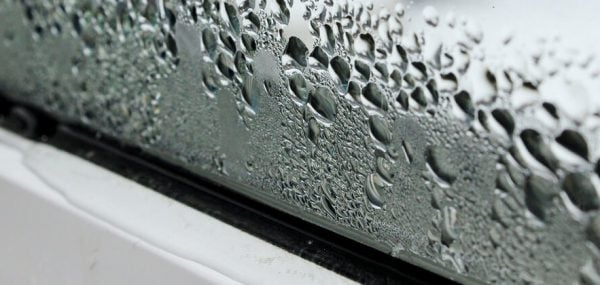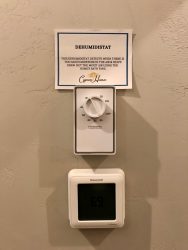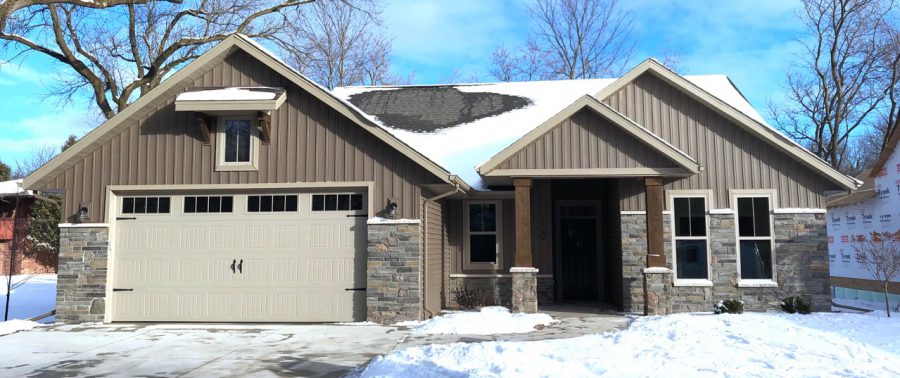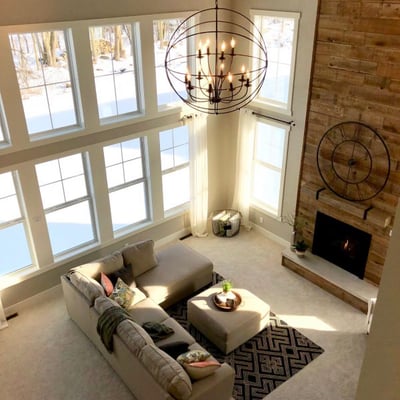
Foggy Winter Windows May Have Nothing To Do With The Windows
January 25, 2019
Published by Greg Drusch
Each year when the temperature dips below zero, we inevitably receive warranty calls about faulty windows. Windows that were performing perfectly well are now covered in condensation. These homeowners don’t actually have a window problem, they have a humidity problem. The extreme cold air outside causes the window panes to cool and humidity of the indoor air can then condense into water on the surface. Luckily, for Cypress homeowners, the solution is often just the turn of a dial.
Having the correct level of humidity in your home is important all year long, but it becomes even more crucial to monitor the moisture in your home during our Wisconsin Winters. You want to have a certain amount of humidity in your home for general health and wellness, but this becomes a delicate balance when outside temperatures fall below freezing. At Cypress Homes we’ve put together some helpful information regarding how and why you’ll want to monitor humidity levels in your home.
What Level Humidity Should I Keep My Home at and Why?
Generally, you’ll want humidity levels to be around 45% in your home for your health and your homes condition. If humidity increases above 50%, the additional moisture will make your home more susceptible to mold, bacteria growth, dust mites, insects, and paint peeling problems. If humidity decreases too low you open yourself up to an array of additional problems including brittle wood/drywall and shrunken floors; not to mention dry skin/nose/throat and being more vulnerable to catch a cold.
Unfortunately with Wisconsin temperatures falling below freezing, deciding on the proper level of humidity for your home gets even more complicated. The colder it is outside, the more likely your windows are to start collecting condensation – even at relatively low humidity levels. This means you’ll have to adjust your homes humidity level according to the outside temperature. The University of Minnesota Laboratories developed guidelines for recommended humidity levels based on 70º interior room temperatures:
- When outside temperatures are 20° to 40°F, indoor humidity should be about 40%
- When outside temperatures are 10° to 20°F, indoor humidity should be about 35%
- When outside temperatures are 0º to 10°F, indoor humidity levels shouldn’t exceed 30%
- When outside temperatures are -10º to 0°F, indoor humidity levels shouldn’t exceed 25%
- When outside temperatures are -20º to -10°F, indoor humidity levels shouldn’t exceed 20%
- When outside temperatures are -20ºF and below, indoor humidity levels shouldn’t exceed 15%
How to Control Humidity Levels in Your Home

The easiest way to control your humidity level is to install a dehumidistat in your home. All of the homes we build at Cypress Homes include a dehumidistat and high rated exhaust fans. This makes lowering your humidity as easy as turning a dial. A higher level of ventilation is just one of the many features we include at Cypress Homes to make homes 25-30% more energy efficient than code; Homes built by Cypress Homes are certified to meet “Focus on Energy New Home” standards.
You can also try these tips to help control your humidity levels:
- Use a humidifier or dehumidifier to add or remove moisture from your home
- Use your exhaust fans during and after bathing and cooking to remove excess moisture.
- Run fans to circulate air throughout your home
- Check behind closed blinds and drapes to ensure proper air flow
- Regularly replace your AC / furnace air filters
- Be aware of how much moisture you are putting into your home
- Cook with covered pots
- Take cooler, shorter showers
- Reduce the number of plants in your home
- Make sure your clothes dryer is vented to the outdoors.
Categorized in: Home Tips, Cypress Homes, Uncategorized, Home Care, Winterizing
This post was written by Greg Drusch
 Blueprints Blog
Blueprints Blog
- Custom-Built Altamonte in Auburn Estates
- Custom Kari - Neenah, WI
- Custom Anabelle: A Beautiful 1 1/2-Story Home
- The Cottonwood - Built in Harrison, WI
- Custom Ranch - Built in Caledonia, WI
Popular Posts
Archives
- July 2012 (16)
- November 2011 (13)
- April 2020 (10)
- June 2012 (9)
- July 2013 (9)
- July 2016 (9)
- August 2016 (9)
- October 2016 (9)
- November 2016 (9)
- October 2017 (9)
- January 2012 (8)
- June 2016 (8)
- September 2016 (8)
- April 2017 (8)
- October 2011 (7)
- May 2012 (7)
- November 2012 (7)
- June 2013 (7)
- February 2017 (7)
- December 2011 (6)
- March 2012 (6)
- October 2013 (6)
- January 2017 (6)
- September 2017 (6)
- November 2017 (6)
- March 2020 (6)
- February 2012 (5)
- September 2013 (5)
- March 2017 (5)
- March 2019 (5)
- July 2019 (5)
- July 2020 (5)
- August 2020 (5)
- September 2020 (5)
- March 2021 (5)
- April 2021 (5)
- February 2023 (5)
- August 2012 (4)
- April 2014 (4)
- December 2016 (4)
- February 2019 (4)
- August 2019 (4)
- October 2019 (4)
- November 2019 (4)
- June 2020 (4)
- June 2021 (4)
- September 2021 (4)
- October 2021 (4)
- March 2022 (4)
- June 2024 (4)
- September 2012 (3)
- August 2013 (3)
- November 2013 (3)
- May 2017 (3)
- June 2017 (3)
- January 2019 (3)
- April 2019 (3)
- May 2019 (3)
- June 2019 (3)
- May 2020 (3)
- August 2021 (3)
- January 2022 (3)
- February 2022 (3)
- October 2022 (3)
- July 2024 (3)
- September 2024 (3)
- December 2024 (3)
- January 2025 (3)
- January 2013 (2)
- February 2013 (2)
- March 2013 (2)
- April 2013 (2)
- May 2013 (2)
- January 2014 (2)
- February 2014 (2)
- June 2014 (2)
- August 2014 (2)
- October 2015 (2)
- April 2016 (2)
- July 2017 (2)
- August 2017 (2)
- December 2017 (2)
- January 2018 (2)
- September 2018 (2)
- November 2018 (2)
- September 2019 (2)
- December 2019 (2)
- January 2020 (2)
- October 2020 (2)
- November 2020 (2)
- December 2020 (2)
- January 2021 (2)
- February 2021 (2)
- July 2021 (2)
- November 2021 (2)
- December 2021 (2)
- November 2022 (2)
- March 2023 (2)
- June 2023 (2)
- September 2023 (2)
- April 2024 (2)
- May 2024 (2)
- October 2024 (2)
- November 2024 (2)
- April 2012 (1)
- October 2012 (1)
- December 2012 (1)
- November 2014 (1)
- January 2015 (1)
- March 2015 (1)
- April 2015 (1)
- May 2015 (1)
- July 2015 (1)
- August 2015 (1)
- November 2015 (1)
- December 2015 (1)
- February 2016 (1)
- May 2016 (1)
- February 2018 (1)
- March 2018 (1)
- April 2018 (1)
- June 2018 (1)
- February 2020 (1)
- May 2021 (1)
- April 2022 (1)
- May 2022 (1)
- June 2022 (1)
- August 2022 (1)
- September 2022 (1)
- December 2022 (1)
- August 2023 (1)
- October 2023 (1)
- December 2023 (1)
- August 2024 (1)
- February 2025 (1)
- March 2025 (1)
- April 2025 (1)
Blog Categories
- Home Tips (193)
- Design (186)
- Cypress Homes (164)
- Custom Homes (96)
- Living Tips (88)
- Area Events (66)
- Uncategorized (63)
- Community Profiles (31)
- Poll Winners (25)
- Testimonials (24)
- Featured Subdivisions (23)
- Cypress In The News (16)
- Winterizing (9)
- Home Care (7)
- Home Space of the Month (7)
- In the News (6)
.png?width=523&height=243&name=white-cypress-homes-logo-1%20(1).png)


